-

Introduction to Networks
Chapter 1: Objectives
- After completing this chapter, students will be able to:
- Explain how multiple networks are used in everyday life.
- Explain the topologies and devices used in a small- to medium-sized business network.
- Explain the basic characteristics of a network that supports communication in a small- to medium-sized business.
- Explain trends in networking that will affect the use of networks in small to medium-sized businesses.
Chapter 1
- Globally Connected
- LANs, WANs, and the Internet
- The Network as a Platform
- The Changing Network Environment
- Summary
-

Interconnecting Our Lives
Networking Impacts in Our Daily Lives
Networks Support the Way We Learn
- Networks have changed the way we learn. Access to high quality instruction is no longer restricted to students living in proximity to where that instruction is being delivered. Online distance learning has removed geographic barriers and improved student opportunity. Robust and reliable networks support and enrich student learning experiences. They deliver learning material in a wide range of formats including interactive activities, assessments, and feedback.
Networks Support the Way We Communicate
- The globalisation of the Internet has ushered in new forms of communication that empower individuals to create information that can be accessed by a global audience. Some forms of communication include: Texting – Texting enables instant real-time communication between two or more people. Social Media – Social media consists of interactive websites where people and communities create and share user-generated content with friends, family, peers, and the world. Collaboration Tools - Without the constraints of location or time zone, collaboration tools allow individuals to communicate with each other, often across real-time interactive video. The broad distribution of data networks means that people in remote locations can contribute on an equal basis with people in the heart of large population centers. Blogs - Blogs, which is an abbreviation of the word “weblogs”, are web pages that are easy to update and edit. Unlike commercial websites, blogs give anyone a means to communicate their thoughts to a global audience without technical knowledge of web design. Wikis - Wikis are web pages that groups of people can edit and view together. Whereas a blog is more of an individual, personal journal, a wiki is a group creation. As such, it may be subject to more extensive review and editing. Many businesses use wikis as their internal collaboration tool. Podcasting - Podcasting allows people to deliver their audio recordings to a wide audience. The audio file is placed on a website (or blog or wiki) where others can download it and play the recording on their computers, laptops, and other mobile devices. Peer-to-Peer (P2P) File Sharing – Peer-to-Peer file sharing allows people to share files with each other without having to store and download them from a central server. The user joins the P2P network by simply installing the P2P software. P2P file sharing has not been embraced by everyone. Many people are concerned about violating the laws of copyrighted materials. What other sites or tools do you use to share your thoughts?
Networking Today
Networks in Our Past and Daily Lives
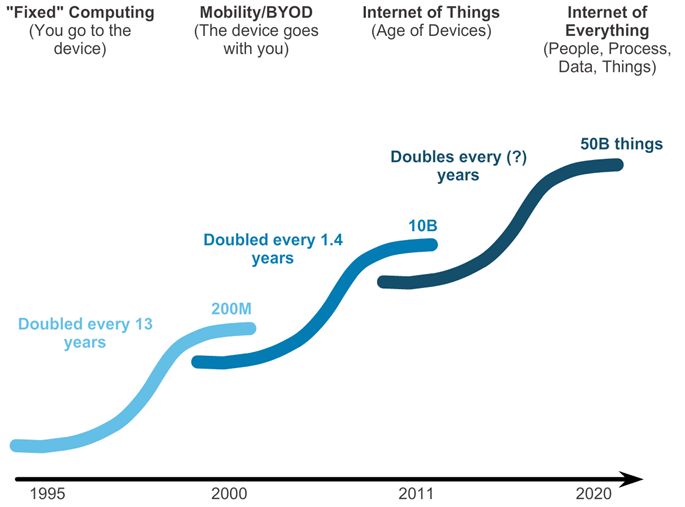
- Among all of the essentials for human existence, the need to interact with others ranks just below our need to sustain life. Communication is almost as important to us as our reliance on air, water, food, and shelter. In today’s world, through the use of networks, we are connected like never before. People with ideas can communicate instantly with others to make those ideas a reality. News events and discoveries are known worldwide in seconds. Individuals can even connect and play games with friends separated by oceans and continents.
- 📷 The Global Community
X
-
Networks of Many Sizes
- Move your mouse over the images to get more information.


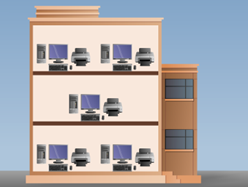
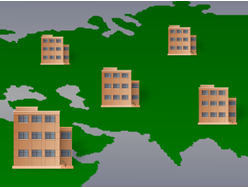
Networking Impacts in Our Daily Lives cont...
Networks support the way we work.
- In the business world, data networks were initially used by businesses to internally record and manage financial information, customer information, and employee payroll systems. These business networks evolved to enable the transmission of many different types of information services, including email, video, messaging, and telephony. The use of networks to provide efficient and cost-effective employee training is increasing in acceptance. Online learning opportunities can decrease time-consuming and costly travel, yet still ensure that all employees are adequately trained to perform their jobs in a safe and productive manner. There are many success stories illustrating innovative ways networks are being used to make us more successful in the workplace. Some of these scenarios are available through the Cisco web site at http://www.cisco.com/web/about/success-stories/index.html.
Networks Support the Way We Play
- The Internet is used for traditional forms of entertainment. We listen to recording artists, preview or view motion pictures, read entire books, and download material for future offline access. Live sporting events and concerts can be experienced as they are happening, or recorded and viewed on demand. Networks enable the creation of new forms of entertainment, such as online games. Players participate in any kind of online competition that game designers can imagine. We compete with friends and foes around the world as if we were all in the same room. Even offline activities are enhanced using network collaboration services. Global communities of interest have grown rapidly. We share common experiences and hobbies well beyond our local neighborhood, city, or region. Sports fans share opinions and facts about their favorite teams. Collectors display prized collections and get expert feedback about them. Whatever form of recreation we enjoy, networks are improving our experience. How do you play on the Internet?
-
Peer to Peer

- The advantages of peer-to-peer networking:
- Easy to set up
- Less complexity
- Lower cost since network devices and dedicated servers may not be required
- Can be used for simple tasks such as transferring files and sharing printers
- The disadvantages of peer-to-peer networking:
- No centralised administration
- Not as secure
- Not scalable
- All devices may act as both clients and servers which can slow their performance
- Client and server software usually runs on separate computers, but it is also possible for one computer to carry out both roles at the same time. In small businesses and homes, many computers function as the servers and clients on the network. This type of network is called a peer-to-peer network. The advantages and disadvantages of peer-to-peer networking are shown in the figure.
Networks of Many Sizes cont...
- Networks come in all sizes. They can range from simple networks consisting of two computers to networks connecting millions of devices. Click the images in the figure to read about networks of different sizes. Simple networks installed in homes enable sharing of resources, such as printers, documents, pictures and music between a few local computers. Home office networks and small office networks are often set up by individuals that work from a home or a remote office and need to connect to a corporate network or other centralized resources. Additionally, many self-employed entrepreneurs use home office and small office networks to advertise and sell products, order supplies and communicate with customers. In businesses and large organizations, networks can be used on an even broader scale to provide consolidation, storage, and access to information on network servers. Networks also allow for rapid communication such as email, instant messaging, and collaboration among employees. In addition to internal benefits, many organizations use their networks to provide products and services to customers through their connection to the Internet. The Internet is the largest network in existence. In fact, the term Internet means a ‘network of networks’. The Internet is literally a collection of interconnected private and public networks, such as those described above.
Clients and Servers
- All computers connected to a network that participate directly in network communication are classified as hosts. Hosts are also called end devices. Servers are computers with software that enable them to provide information, like email or web pages, to other end devices on the network. Each service requires separate server software. For example, a server requires web server software in order to provide web services to the network. A computer with server software can provide services simultaneously to one or many clients. Additionally, a single computer can run multiple types of server software. In a home or small business, it may be necessary for one computer to act as a file server, a web server, and an email server. Clients are computers with software installed that enable them to request and display the information obtained from the server. An example of client software is a web browser, like Chrome or FireFox. A single computer can also run multiple types of client software. For example, a user can check email and view a web page while instant messaging and listening to Internet radio.
-
End Devices
- Some examples of end devices are:
- Computers (work stations, laptops, file servers, web servers)
- Network printers
- VoIP phones
- TelePresence endpoint
- Security cameras
- Mobile handheld devices (such as smart phones, tablets, PDAs, and wireless debit / credit card readers and barcode scanners)
Network Infrastructure Devices
- Examples of intermediary network devices are:
- Network Access Devices (switches, and wireless access points)
- Internetworking Devices (routers)
- Security Devices (firewalls)
Network Media
- Communication across a network is carried on a medium. The medium provides the channel over which the message travels from source to destination.
- Modern networks primarily use three types of media to interconnect devices and to provide the pathway over which data can be transmitted. These media are:
- Metallic wires within cables - data is encoded into electrical impulses
- Glass or plastic fibers (fiber optic cable) - data is encoded as pulses of light
- Wireless transmission - data is encoded using wavelengths from the electromagnetic spectrum
- Different types of network media have different features and benefits. Not all network media have the same characteristics, nor are they all appropriate for the same purpose.
- 📷 Network Media Diagram
Components of a Network
- There are three categories of network components:
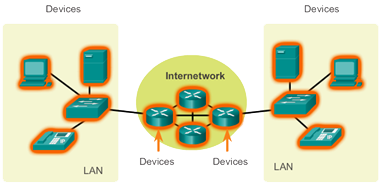


- The path that a message takes from source to destination can be as simple as a single cable connecting one computer to another, or as complex as a collection of networks that literally spans the globe. This network infrastructure provides the stable and reliable channel over which these communications occur.
- The network infrastructure contains three categories of network components:
- Devices
- Media
- Services
- Devices and media are the physical elements, or hardware, of the network. Hardware is often the visible components of the network platform such as a laptop, PC, switch, router, wireless access point, or the cabling used to connect the devices.
- Services include many of the common network applications people use every day, like email hosting services and web hosting services. Processes provide the functionality that directs and moves the messages through the network. Processes are less obvious to us but are critical to the operation of networks.
X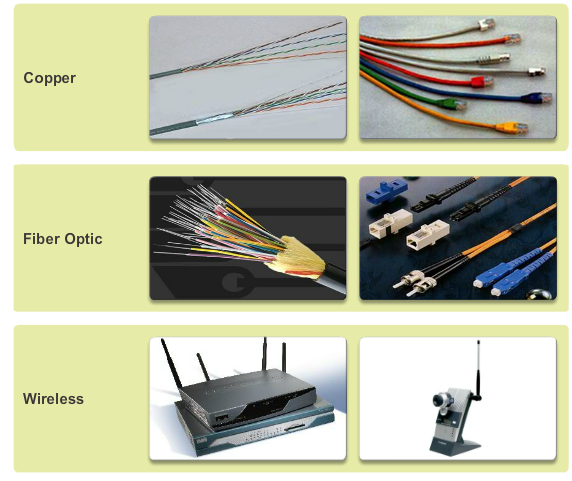
-
Types of Networks
- Network infrastructures can vary greatly in terms of:
- Size of the area covered
- Number of users connected
- Number and types of services available
- Area of responsibility
- Local Area Network (LAN) - A network infrastructure that provides access to users and end devices in a small geographical area, which is typically an enterprise, home, or small business network owned and managed by an individual or IT department.
- Wide Area Network (WAN) - A network infrastructure that provides access to other networks over a wide geographical area, which is typically owned and managed by a telecommunications service provider.
- Other types of networks include:
- Metropolitan Area Network (MAN) - A network infrastructure that spans a physical area larger than a LAN but smaller than a WAN (e.g., a city). MANs are typically operated by a single entity such as a large organization.
- Wireless LAN (WLAN) - Similar to a LAN but wirelessly interconnects users and end points in a small geographical area.
- Storage Area Network (SAN) - A network infrastructure designed to support file servers and provide data storage, retrieval, and replication.
LANs and WANs and the Internet
Local Area Networks
- LANs are a network infrastructure that spans a small geographical area. Specific features of LANs include:
- LANs interconnect end devices in a limited area such as a home, school, office building, or campus.
- A LAN is usually administered by a single organization or individual. The administrative control that governs the security and access control policies are enforced on the network level.
- LANs provide high speed bandwidth to internal end devices and intermediary devices.
- 📷 LAN Diagram
Network Representations
- Diagrams of networks often use symbols, like those shown in Figure 1, to represent the different devices and connections that make up a network. A diagram provides an easy way to understand how devices in a large network are connected. This type of “picture” of a network is known as a topology diagram. The ability to recognize the logical representations of the physical networking components is critical to being able to visualize the organization and operation of a network.
- In addition to these representations, specialized terminology is used when discussing how each of these devices and media connect to each other. Important terms to remember are:
- Network Interface Card - A NIC, or LAN adapter, provides the physical connection to the network at the PC or other end device. The media that are connecting the PC to the networking device, plug directly into the NIC.
- Physical Port - A connector or outlet on a networking device where the media is connected to an end device or another networking device.
- Interface - Specialized ports on a networking device that connect to individual networks. Because routers are used to interconnect networks, the ports on a router are referred to as network interfaces.
- Note: Often, the terms port and interface are used interchangeably.
- 📷 Network Representation Diagram
Topology Diagrams
- Topology diagrams are mandatory for anyone working with a network. They provide a visual map of how the network is connected.
- There are two types of topology diagrams:
- 📷 Physical topology diagrams - Identify the physical location of intermediary devices and cable installation.
- 📷 Logical topology diagrams - Identify devices, ports, and addressing scheme.
- The topologies shown in the physical and logical diagrams are appropriate for your level of understanding at this point in the course. Search the Internet for “network topology diagrams” to see some more complex examples. If you add the “Cisco” to your search phrase, you will find many topologies using similar icons.
X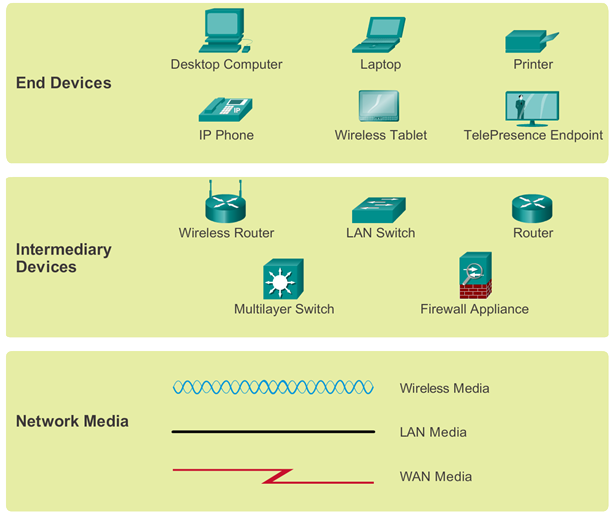 X
X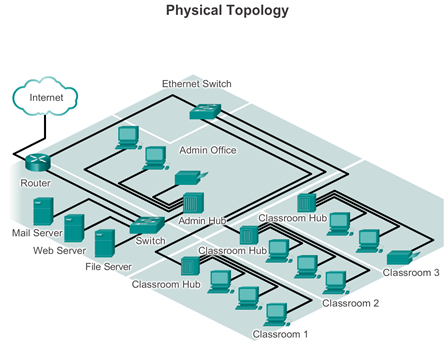 X
X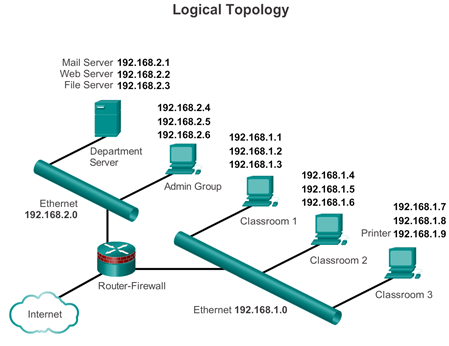 X
X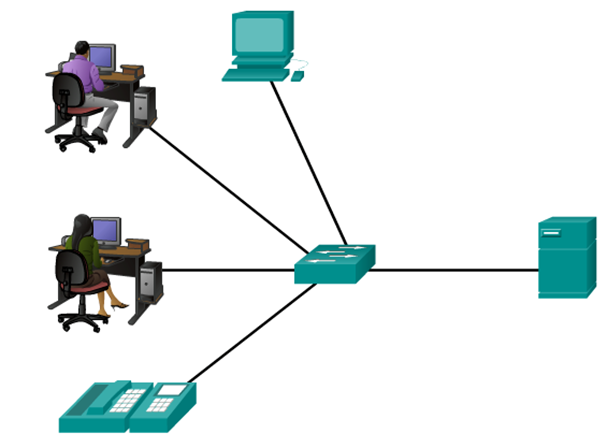
-
Intranets and Extranets
- There are two other terms which are similar to the term Internet:
- Intranet
- Extranet
- Intranet is a term often used to refer to a private connection of LANs and WANs that belongs to an organization, and is designed to be accessible only by the organization's members, employees, or others with authorization.
- An organization may use an extranet to provide secure and safe access to individuals who work for a different organization, but require access to the organization’s data. Examples of extranets include:
- A company that is providing access to outside suppliers and contractors.
- A hospital that is providing a booking system to doctors so they can make appointments for their patients.
- A local office of education that is providing budget and personnel information to the schools in its district.
- 📷 Intranets and Extranets Diagram
Wide Area Networks
- WANs are a network infrastructure that spans a wide geographical area. WANs are typically managed by service providers (SP) or Internet Service Providers (ISP).
- Specific features of WANs include:
- WANs interconnect LANs over wide geographical areas such as between cities, states, provinces, countries, or continents.
- WANs are usually administered by multiple service providers.
- WANs typically provide slower speed links between LANs.
- 📷 WAN Diagram
The Internet
- The Internet is a worldwide collection of interconnected networks (internetworks or internet for short). The figure shows one way to view the Internet as a collection of interconnected LANs and WANs. Some of the LAN examples are connected to each other through a WAN connection. WANs are then connected to each other. The red WAN connection lines represent all the varieties of ways we connect networks. WANs can connect through copper wires, fiber optic cables, and wireless transmissions (not shown). The Internet is not owned by any individual or group. Ensuring effective communication across this diverse infrastructure requires the application of consistent and commonly recognized technologies and standards as well as the cooperation of many network administration agencies. There are organizations that have been developed for the purpose of helping to maintain structure and standardization of Internet protocols and processes. These organizations include the Internet Engineering Task Force (IETF), Internet Corporation for Assigned Names and Numbers (ICANN), and the Internet Architecture Board (IAB), plus many others. Note: The term internet (with a lower case “i") is used to describe multiple networks interconnected. When referring to the global system of interconnected computer networks or the World Wide Web, the term Internet (with a capital “I”) is used.
- 📷 The Internet
X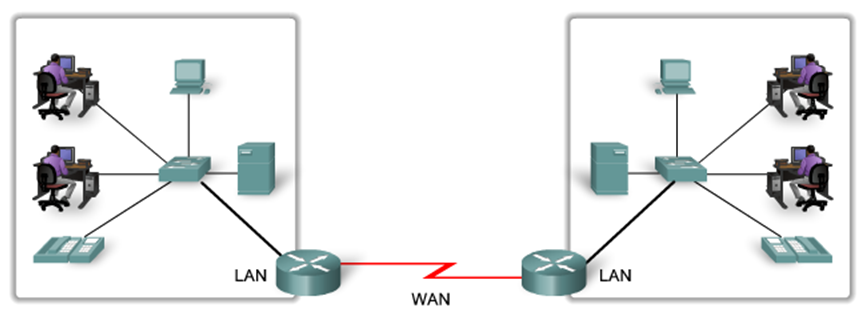 X
X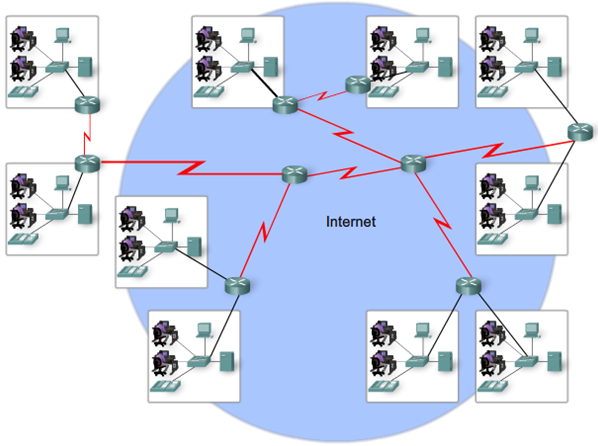 X
X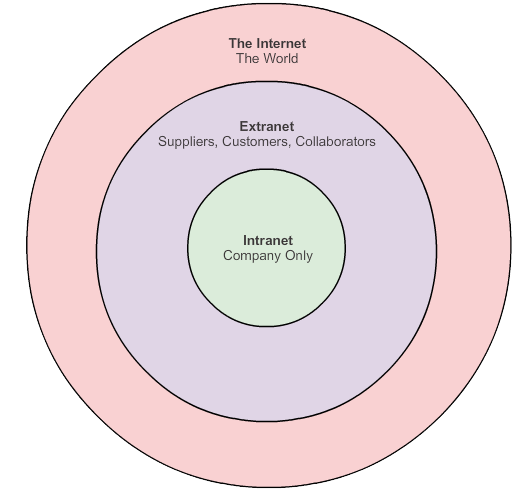
-
Connecting to the Internet
Home and Small Office Internet Connections
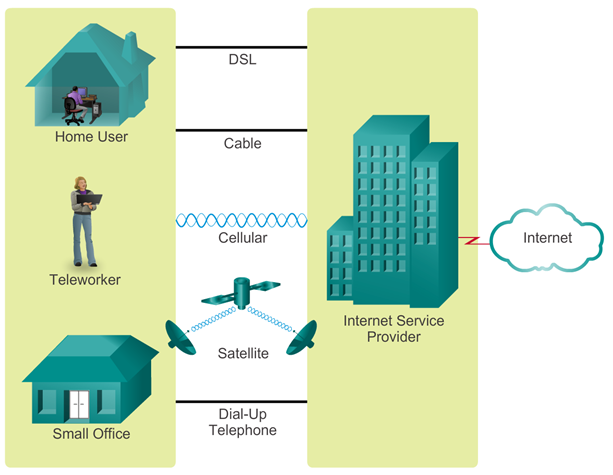
- Cable - Typically offered by cable television service providers, the Internet data signal is carried on the same cable that delivers cable television. It provides a high bandwidth, always on, connection to the Internet.
- DSL - Digital Subscriber Lines provide a high bandwidth, always on, connection to the Internet. DSL runs over a telephone line. In general, small office and home office users connect using Asymmetrical DSL (ADSL), which means that the download speed is faster than the upload speed.
- Cellular - Cellular Internet access uses a cell phone network to connect. Wherever you can get a cellular signal, you can get cellular Internet access. Performance will be limited by the capabilities of the phone and the cell tower to which it is connected.
- Satellite - The availability of satellite Internet access is a real benefit in those areas that would otherwise have no Internet connectivity at all. Satellite dishes require a clear line of sight to the satellite.
- Dial-up Telephone - An inexpensive option that uses any phone line and a modem. The low bandwidth provided by a dial-up modem connection is usually not sufficient for large data transfer, although it is useful for mobile access while traveling.
- Many homes and small offices are more commonly being connected directly with fiber optic cables. This enables an ISP to provide higher bandwidth speeds and support more services such as Internet, phone, and TV.
- The choice of connection varies depending on geographical location and service provider availability.
Businesses Internet Connections
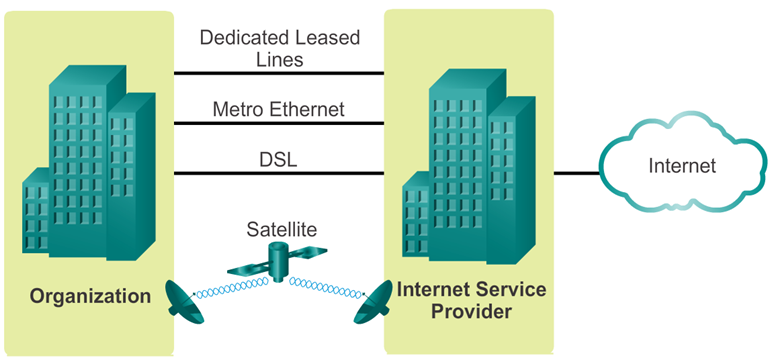
- Corporate connection options differ from home user options. Businesses may require higher bandwidth, dedicated bandwidth, and managed services. Connection options available differ depending on the type of service providers located nearby.
- Dedicated Leased Line - Leased lines are actually reserved circuits within the service provider’s network that connect geographically separated offices for private voice and/or data networking. The circuits are typically rented at a monthly or yearly rate. They can be expensive.
- Ethernet WAN - Ethernet WANs extend LAN access technology into the WAN. Ethernet is a LAN technology you will learn about in a later chapter. The benefits of Ethernet are now being extended into the WAN.
- DSL - Business DSL is available in various formats. A popular choice is Symmetric Digital Subscriber Lines (SDSL) which is similar to the consumer version of DSL, but provides uploads and downloads at the same speeds.
- Satellite - Similar to small office and home office users, satellite service can provide a connection when a wired solution is not available.
- The choice of connection varies depending on geographical location and service provider availability.
-

Fault Tolerance
- The expectation is that the Internet is always available to the millions of users who rely on it. This requires a network architecture that is built to be fault tolerant. A fault tolerant network is one that limits the impact of a failure, so that the fewest number of devices are affected. It is also built in a way that allows quick recovery when such a failure occurs. These networks depend on multiple paths between the source and destination of a message. If one path fails, the messages can be instantly sent over a different link. Having multiple paths to a destination is known as redundancy. One way reliable networks provide redundancy is by implementing a packet-switched network. Packet switching splits traffic into packets that are routed over a shared network. A single message, such as an email or a video stream, is broken into multiple message blocks, called packets. Each packet has the necessary addressing information of the source and destination of the message. The routers within the network switch the packets based on the condition of the network at that moment. This means that all the packets in a single message could take very different paths to the destination. In the figure, the user is not aware and is unaffected by the router dynamically changing the route when a link fails. This is not the case in circuit-switched networks traditionally used for voice communications. A circuit-switched network is one that establishes a dedicated circuit between the source and destination before the users may communicate. If the call is unexpectedly terminated, the users must initiate a new connection.
- 📷 Fault Tolerance in Circuit Switched Network
The Converging Network
Traditional Separate Networks
- Consider a school built thirty years ago. Back then, some classrooms were cabled for the data network, telephone network, and video network for televisions. These separate networks could not communicate with each other, as shown in the figure. Each network used different technologies to carry the communication signal. Each network had its own set of rules and standards to ensure successful communication.
- 📷 Multiple Networks Diagram
Converged Networks
- Today, the separate data, telephone, and video networks are converging. Unlike dedicated networks, converged networks are capable of delivering data, voice, and video between many different types of devices over the same network infrastructure, as shown in the figure. This network infrastructure uses the same set of rules, agreements, and implementation standards.
- 📷 Converged Networks Diagram
Supporting Network Architecture
Network Architecture
- As networks evolve, we are discovering that there are four basic characteristics that the underlying architectures need to address in order to meet user expectations:
- Fault Tolerance
- Scalability
- Quality of Service (QoS)
- Security
X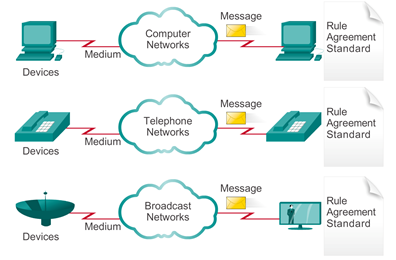 X
X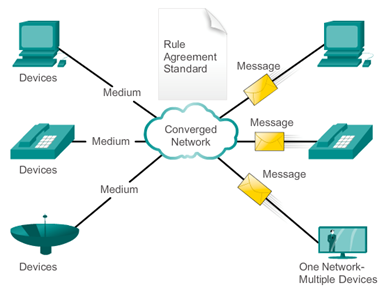 X
X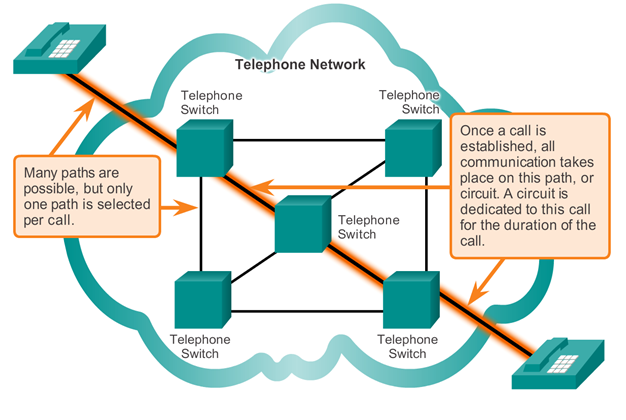
-
Security
- The network infrastructure, services, and the data contained on network-attached devices are crucial personal and business assets. There are two types of network security concerns that must be addressed: network infrastructure security and information security. Securing a network infrastructure includes the physical securing of devices that provide network connectivity, and preventing unauthorized access to the management software that resides on them. Information security refers to protecting the information contained within the packets being transmitted over the network and the information stored on network attached devices. In order to achieve the goals of network security, there are three primary requirements:
- Confidentiality - Data confidentiality means that only the intended and authorized recipients can access and read data.
- Integrity - Data integrity means having the assurance that the information has not been altered in transmission, from origin to destination.
- Availability - Data availability means having the assurance of timely and reliable access to data services for authorized users.
- 📷 Security
Providing QoS
- Examples of priority decisions for an organization might include:
- Time-sensitive communication - increase priority for services like telephony or video distribution.
- Non time-sensitive communication - decrease priority for web page retrieval or email.
- High importance to organization - increase priority for production control or business transaction data.
- Undesirable communication - decrease priority or block unwanted activity, like peer-to-peer file sharing or live entertainment.
Supporting Network Architecture cont...
Scalability
- A scalable network can expand quickly to support new users and applications without impacting the performance of the service being delivered to existing users. The figure shows how a new network can be easily added to an existing network. In addition, networks are scalable because the designers follow accepted standards and protocols. This allows software and hardware vendors to focus on improving products and services without worrying about designing a new set of rules for operating within the network.
- 📷 Scalable Networks
Quality of Service
- Quality of Service (QoS) is also an ever increasing requirement of networks today. New applications available to users over internetworks, such as voice and live video transmissions, create higher expectations for the quality of the delivered services. Have you ever tried to watch a video with constant breaks and pauses? As data, voice, and video content continue to converge onto the same network, QoS becomes a primary mechanism for managing congestion and ensuring reliable delivery of content to all users. Congestion occurs when the demand for bandwidth exceeds the amount available. Network bandwidth is measured in the number of bits that can be transmitted in a single second, or bits per second (bps). When simultaneous communications are attempted across the network, the demand for network bandwidth can exceed its availability, creating network congestion. When the volume of traffic is greater than what can be transported across the network, devices queue, or hold, the packets in memory until resources become available to transmit them. In the figure, one user is requesting a web page and another is on a phone call. With a QoS policy in place, the router can manage the flow of data and voice traffic, giving priority to voice communications if the network experiences congestion.
- 📷 Quality of Service
X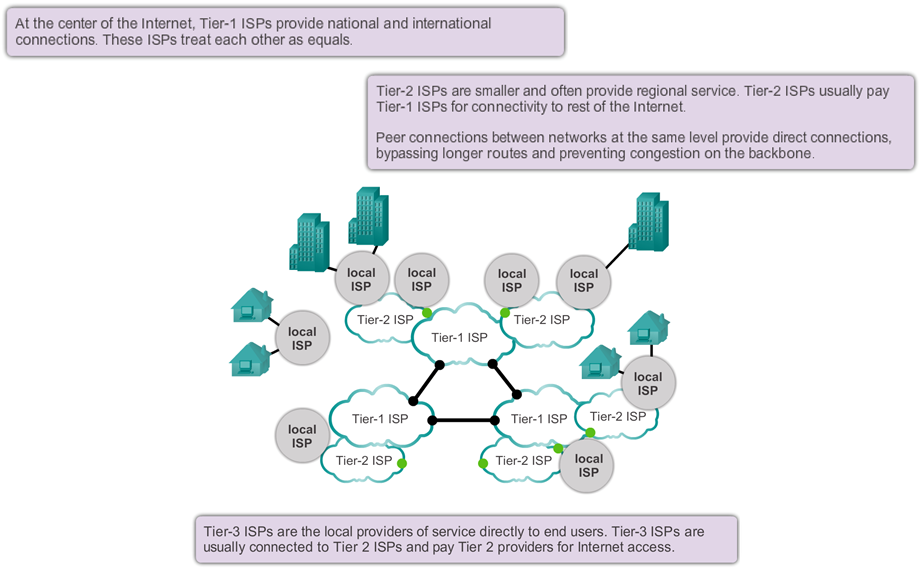 X
X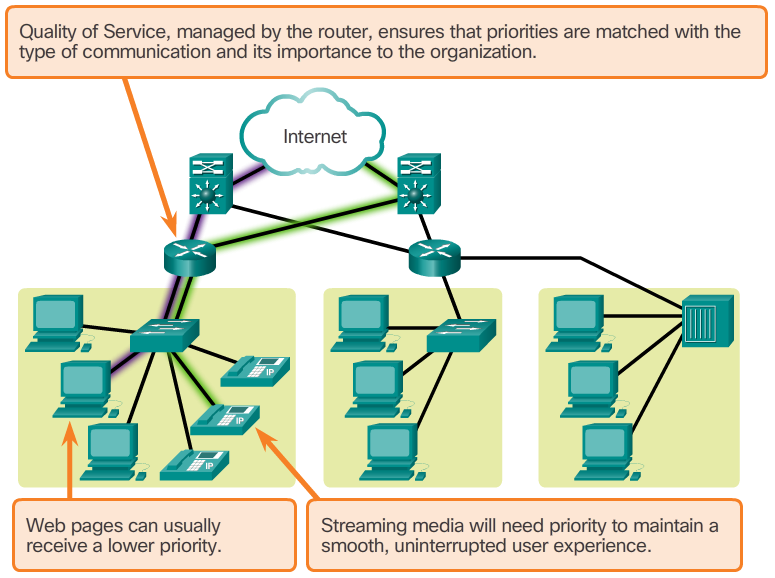 X
X
-

Online Collaboration
- Individuals want to connect to the network, not only for access to data applications, but also to collaborate with one another. Collaboration is defined as “the act of working with another or others on a joint project.” Collaboration tools, like Cisco WebEx shown in the figure, give employees, students, teachers, customers, and partners a way to instantly connect, interact, and achieve their objectives. For businesses, collaboration is a critical and strategic priority that organizations are using to remain competitive. Collaboration is also a priority in education. Students need to collaborate to assist each other in learning, to develop team skills used in the work force, and to work together on team-based projects.
- 📷 Online collaboration
Video Communication
- Another trend in networking that is critical to the communication and collaboration effort is video. Video is being used for communications, collaboration, and entertainment. Video calls can be made to and from anywhere with an Internet connection. Video conferencing is a powerful tool for communicating with others at a distance, both locally and globally. Video is becoming a critical requirement for effective collaboration as organizations extend across geographic and cultural boundaries. Click Play in the figure to view how TelePresence can be incorporated into everyday life and business.
- 📷 Video
New Trends
- As new technologies and end user devices come to market, businesses and consumers must continue to adjust to this ever-changing environment. The role of the network is transforming to enable the connections between people, devices, and information. There are several new networking trends that will effect organizations and consumers. Some of the top trends include:
- Bring Your Own Device (BYOD)
- Online collaboration
- Video communications
- Cloud computing
Bring Your Own Device
- The concept of any device, to any content, in any manner, is a major global trend that requires significant changes to the way devices are used. This trend is known as Bring Your Own Device (BYOD). BYOD is about end users having the freedom to use personal tools to access information and communicate across a business or campus network. With the growth of consumer devices, and the related drop in cost, employees and students can be expected to have some of the most advanced computing and networking tools for personal use. These personal tools include laptops, netbooks, tablets, smartphones, and e-readers. These can be devices purchased by the company or school, purchased by the individual, or both. BYOD means any device, with any ownership, used anywhere. For example, in the past, a student who needed to access the campus network or the Internet had to use one of the school’s computers. These devices were typically limited and seen as tools only for work done in the classroom or in the library. Extended connectivity through mobile and remote access to the campus network gives students tremendous flexibility and more learning opportunities for the student.
- 📷 Bring Your Own Device (BYOD)
X X
X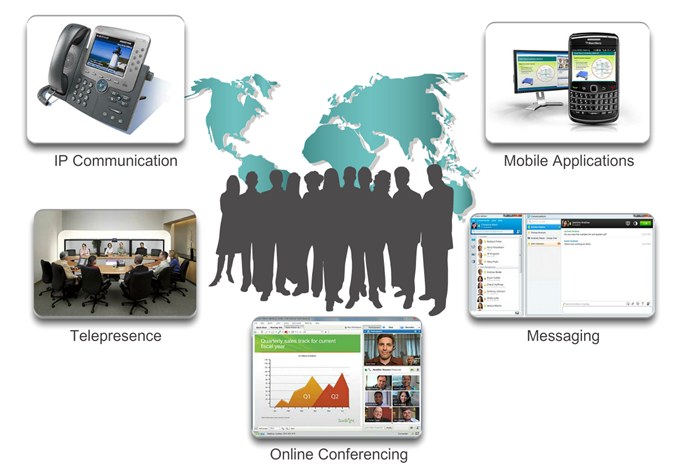 X
X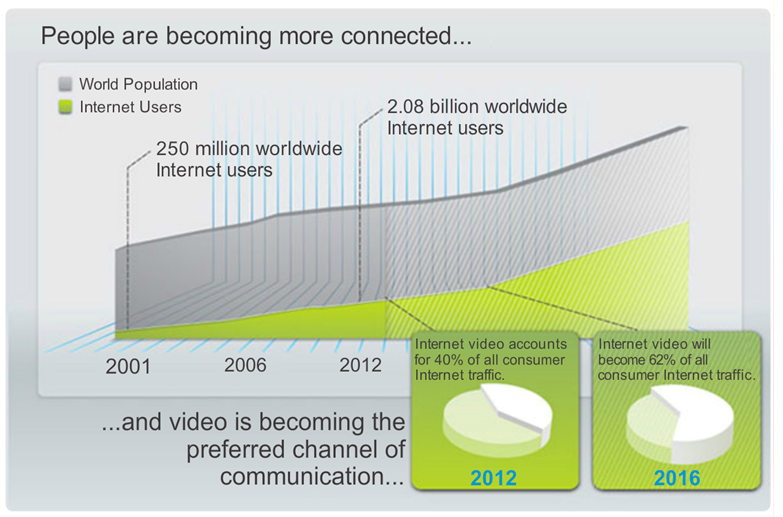
-
New Trends cont...
Cloud Computing
- Cloud computing is another global trend changing the way we access and store data. Cloud computing allows us to store personal files, even backup our entire hard disk drive on servers over the Internet. Applications such as word processing and photo editing can be accessed using the Cloud. For businesses, Cloud computing extends IT's capabilities without requiring investment in new infrastructure, training new personnel, or licensing new software. These services are available on demand and delivered economically to any device anywhere in the world without compromising security or function. Cloud computing is possible because of data centers. A data center is a facility used to house computer systems and associated components. A data center can occupy one room of a building, one or more floors, or an entire building. Data centers are typically very expensive to build and maintain. For this reason, only large organizations use privately built data centers to house their data and provide services to users. Smaller organizations that cannot afford to maintain their own private data center can reduce the overall cost of ownership by leasing server and storage services from a larger data center organization in the Cloud.
Networking Technologies for the Home
Technology Trends in the Home
- Networking trends are not only affecting the way we communicate at work and at school, they are also changing just about every aspect of the home. The newest home trends include ‘smart home technology’. Smart home technology is technology that is integrated into every-day appliances allowing them to interconnect with other devices, making them more ‘smart’ or automated. For example, imagine being able to prepare a dish and place it in the oven for cooking prior to leaving the house for the day. Imagine if the oven was ‘aware’ of the dish it was cooking and was connected to your ‘calendar of events’ so that it could determine what time you should be available to eat, and adjust start times and length of cooking accordingly. It could even adjust cooking times and temperatures based on changes in schedule. Additionally, a smartphone or tablet connection allows the user the ability to connect to the oven directly, to make any desired adjustments. When the dish is “available”, the oven sends an alert message to a specified end user device that the dish is done and warming.
Powerline Networking
- Powerline networking is an emerging trend for home networking that uses existing electrical wiring to connect devices, as shown in the figure. The concept of “no new wires” means the ability to connect a device to the network wherever there is an electrical outlet. This saves the cost of installing data cables and without any additional cost to the electrical bill. Using the same wiring that delivers electricity, powerline networking sends information by sending data on certain frequencies. Using a standard powerline adapter, devices can connect to the LAN wherever there is an electrical outlet. Powerline networking is especially useful when wireless access points cannot be used or cannot reach all the devices in the home. Powerline networking is not designed to be a substitute for dedicated cabling in data networks. However, it is an alternative when data network cables or wireless communications are not a viable option.
- 📷 Powerline Networking
Wireless Broadband
- Connecting to the Internet is vital in smart home technology. DSL and cable are common technologies used to connect homes and small businesses to the Internet. However, wireless may be another option in many areas. Wireless Internet Service Provider (WISP) Wireless Internet Service Provider (WISP) is an ISP that connects subscribers to a designated access point or hot spot using similar wireless technologies found in home wireless local area networks (WLANs). WISPs are more commonly found in rural environments where DSL or cable services are not available. Although a separate transmission tower may be installed for the antenna, it is common that the antenna is attached to an existing elevated structure, such as a water tower or a radio tower. A small dish or antenna is installed on the subscriber’s roof in range of the WISP transmitter. The subscriber’s access unit is connected to the wired network inside the home. From the perspective of the home user, the setup is not much different than DSL or cable service. The main difference is that the connection from the home to the ISP is wireless instead of a physical cable. Wireless Broadband Service Another wireless solution for the home and small businesses is wireless broadband, as shown in the figure. This uses the same cellular technology used to access the Internet with a smart phone or tablet. An antenna is installed outside the house providing either wireless or wired connectivity for devices in the home. In many areas, home wireless broadband is competing directly with DSL and cable services.
- 📷 Wireless Broadband
X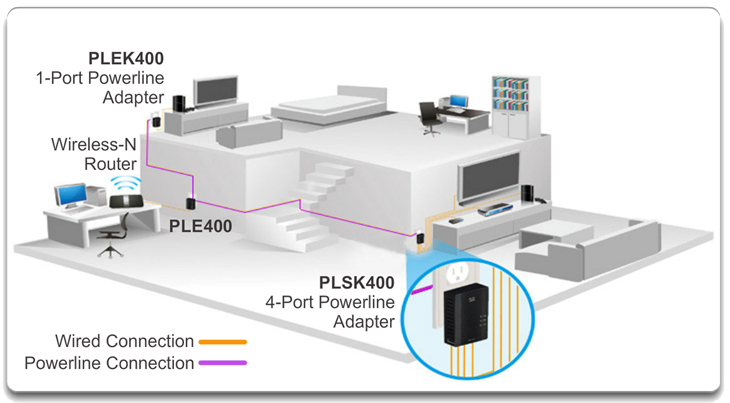 X
X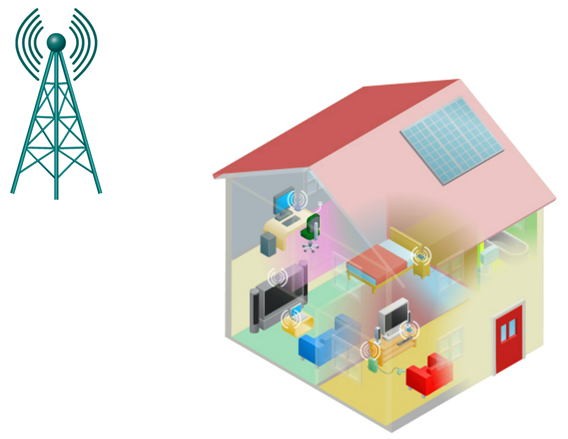
-
Security Solutions
- No single solution can protect the network from the variety of threats that exist. For this reason, security should be implemented in multiple layers, using more than one security solution. If one security component fails to identify and protect the network, others still stand. A home network security implementation is usually rather basic. It is generally implemented on the connecting end devices, as well as at the point of connection to the Internet, and can even rely on contracted services from the ISP. In contrast, the network security implementation for a corporate network usually consists of many components built into the network to monitor and filter traffic. Ideally, all components work together, which minimizes maintenance and improves security. Network security components for a home or small office network should include, at a minimum:
- Antivirus and antispyware – These are used to protect end devices from becoming infected with malicious software.
- Firewall filtering – This is used to block unauthorized access to the network. This may include a host-based firewall system that is implemented to prevent unauthorized access to the end device, or a basic filtering service on the home router to prevent unauthorized access from the outside world into the network.
- In addition to the above, larger networks and corporate networks often have other security requirements:
- Dedicated firewall systems – These are used to provide more advanced firewall capabilities that can filter large amounts of traffic with more granularity.
- Access control lists (ACL) – These are used to further filter access and traffic forwarding.
- Intrusion prevention systems (IPS) – These are used to identify fast-spreading threats, such as zero-day or zero-hour attacks.
- Virtual private networks (VPN) – These are used to provide secure access to remote workers.
- Network security requirements must take into account the network environment, as well as the various applications, and computing requirements. Both home environments and businesses must be able to secure their data while still allowing for the quality of service that is expected of each technology. Additionally, the security solution implemented must be adaptable to the growing and changing trends of the network. The study of network security threats and mitigation techniques starts with a clear understanding of the underlying switching and routing infrastructure used to organize network services.
Security Threats
- Network security is an integral part of computer networking, regardless of whether the network is limited to a home environment with a single connection to the Internet or as large as a corporation with thousands of users. The network security that is implemented must take into account the environment, as well as the tools and requirements of the network. It must be able to secure data while still allowing for the quality of service that is expected of the network. Securing a network involves protocols, technologies, devices, tools, and techniques to secure data and mitigate threats. Threat vectors may be external or internal. Many external network security threats today are spread over the Internet. The most common external threats to networks include:
- Viruses, worms, and Trojan horses - malicious software and arbitrary code running on a user device
- Spyware and adware - software installed on a user device that secretly collects information about the user
- Zero-day attacks, also called zero-hour attacks - an attack that occurs on the first day that a vulnerability becomes known
- Hacker attacks - an attack by a knowledgeable person to user devices or network resources
- Denial of service attacks - attacks designed to slow or crash applications and processes on a network device
- Data interception and theft - an attack to capture private information from an organization’s network
- Identity theft - an attack to steal the login credentials of a user in order to access private data
- It is equally important to consider internal threats. There have been many studies that show that the most common data breaches happen because of internal users of the network. This can be attributed to lost or stolen devices, accidental misuse by employees, and in the business environment, even malicious employees. With the evolving BYOD strategies, corporate data is much more vulnerable. Therefore, when developing a security policy, it is important to address both external and internal security threats.
-
Summary
- In this chapter, you learned:
- Networks and the Internet have changed the way we communicate, learn, work, and even play.
- Networks come in all sizes. They can range from simple networks consisting of two computers, to networks connecting millions of devices.
- The Internet is the largest network in existence. In fact, the term Internet means a ‘network of networks. The Internet provides the services that enable us to connect and communicate with our families, friends, work, and interests.
- The network infrastructure is the platform that supports the network. It provides the stable and reliable channel over which communication can occur. It is made up of network components including end devices, intermediate devices, and network media.
- Networks must be reliable.
- Network security is an integral part of computer networking, regardless of whether the network is limited to a home environment with a single connection to the Internet, or as large as a corporation with thousands of users.
- The network infrastructure can vary greatly in terms of size, number of users, and number and types of services that are supported on it. The network infrastructure must grow and adjust to support the way the network is used. The routing and switching platform is the foundation of any network infrastructure.